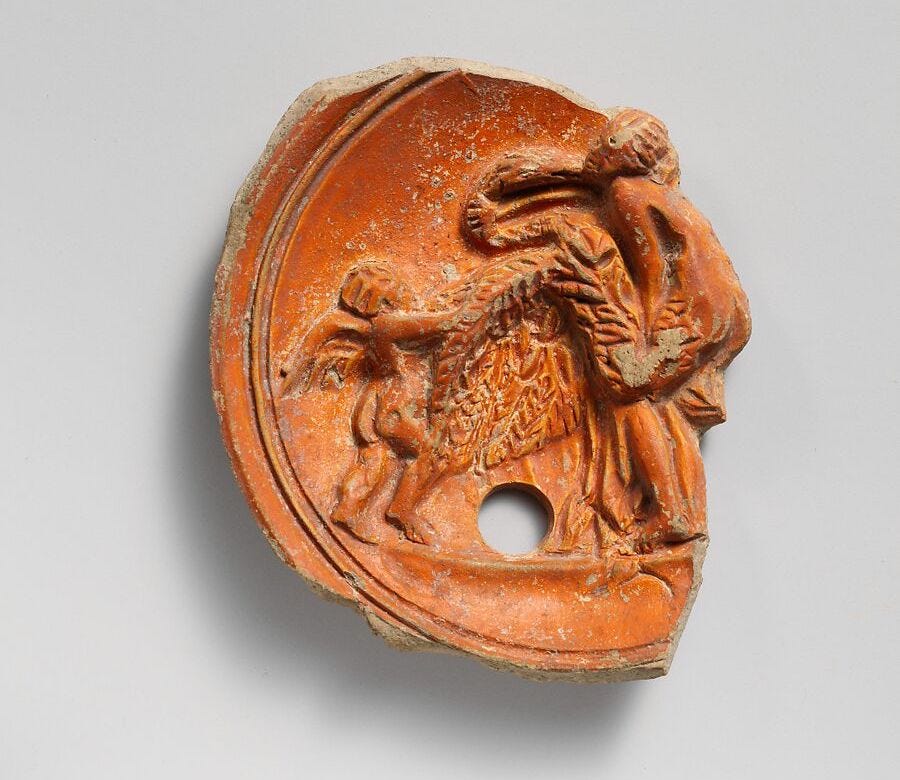Ledas and Swans at The Met
A virtual Leda and the Swan tour of the Metropolitan Museum of Art
For me, one of the most wonderful parts about being in New York City is the art. Masterworks from every prominent culture throughout history can be found—often for free or nearly free—around the city.
However, there is one place in particular where if you’re truly looking for masterworks, they’re all right there: the Metropolitan Museum of Art. It is shocking in its scope. It goes well beyond Picasso and Monet, although it has plenty of those too. The museum also has watches, trading cards, books, chairs, petticoats, and endless historical curios and forms of expression from around the world.
Yet my story does not begin at The Met. Rather, it begins at The Met’s more modern-focused cousin a few blocks downtown, the Museum of Modern Art. Though it is no longer on display, in 2017 it was there that I saw Leda and the Swan, an abstract 1962 Cy Twombly painting:

I’ve found Twombly’s art to be divisive. A lot of people say “I could do that” and dismiss it with prejudice. So I’ll wait until the next Cy Twombly exhibit passes through NYC to get on my Twombly soapbox. The purpose of this post is not to sell anyone on modern art, so until then I’ll focus on the subject of this painting instead.
The Ancient Greek myth of Leda and the Swan goes like this: Leda was a queen, and Zeus fell in love with her. One day Zeus disguised himself as a swan and seduced her. She ended up giving birth to two sets of twins at the same time: one pair from being with Zeus, and the other pair from her husband, the king. They both hatched out of eggs, and no one ever knew which twins had which father. Notably, Helen of Troy was one of the children.
Here’s where The Met comes in. After seeing the Twombly painting, I saw a news story that The Met had just made 375,000 images from its collection searchable and publicly accessible. The news made me curious how other artists portrayed the myth of Leda and the Swan. I had a chance not just to look for images online, but actually go experience my tour in person.
When I searched The Met’s online database, I found nine results that were on view and without a doubt pertained to the myth. All of these pieces remain on view as of this writing.
From left to right, top row:
Bachiacca - Leda and the Swan oil on wood painting (ca. 1525)
Roman gold ring with Leda and the Swan carved on the stone inset (ca. 100 AD)
Michel Anguier - Leda and the Swan limestone sculpture (1654)
Aristide Maillol - Leda bronze sculpture (ca. 1929)
French clock with a brass Leda and the Swan as decoration (ca. 1720)
And bottom row:
Italian console table with Leda and the Swan carved along the frieze (ca. 1790)
Italian plate with Leda and the Swan painted on the top (ca. 1535)
Roman broken oil lamp with Leda and the Swan carved on the top (ca. 250 AD)
Jacques Sarazin - Leda and the Swan marble sculpture (ca. 1640)
After work one day (oh, the quaint pre-pandemic days), I embarked on a quest to find them all.
Easier said than done. The hardest one to find was the gold ring. The map pointed me to a gallery of cramped, unlabeled display cases. I spent half an hour combing through the displays, gave up, and decided to come back later. I was stupidly giddy when I finally spotted it the second time around. There was a thin glass of case of gems and stones propped up against a wall. I missed it the first time because only one of those stones was set in a ring—the one featuring Leda and the Swan. The other works of art just required noting the gallery number on the website and deciphering where it was on the map. You can get a lot of steps in at The Met.
When I got home, I read more about the story. Zeus didn’t “seduce” Leda, as it is often written, even sometimes on The Met’s website. The truth is more horrific. I’m embarrassed to admit I didn’t even think about it as I was circling gallery numbers on a museum map. I went back to my photos and looked at them through a new lens. Did any of the artists capture not just the solemnity of a Greek myth, but the trauma of the story?
The Ancient Roman renditions were frankly too hard to discern. Kudos to whoever figured out these were Leda and the Swan in the first place. Heck, the oil lamp relief was fractured and missing the whole bottom half of the lamp.
For the paintings and sculptures, which were far more detailed, Leda looks practically in love. Just take a look at this 16th century Italian painting. (I don’t have a clue who that fifth kid is.)
Only one artist, Aristide Maillol, wasn’t so kind to Zeus. In his sculpture, there is only Leda. She’s crouched and holding her hand out. She looks sad and resigned. It’s as if she’s saying “stop.” Unfortunately, this statue was inside a table service cafe. I only took a quick photo and shuffled out. The far more detailed black-and-white image below is from The Met’s website, not my phone.
All said, at least in my opinion, the artist who rendered the story best is Cy Twombly.




